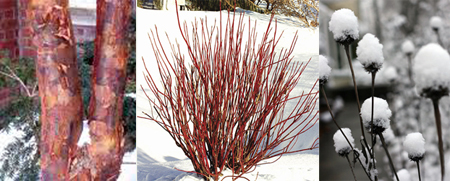Gardening in Winter: Choosing trees for winter beauty
Gardening in the winter? Just when you thought, yah, no more Christmas catalogs in the mail, the gardening catalogs start coming. Before you settle down with a hot cup of tea, your favorite throw and a stack of catalogs, gaze out your windows and see what’s missing in your winter garden. Then as you are amazed by all the lovely new plants available for 2011 and reminisce fondly about a few old favorites, consider choices that add color and interest to the winter landscape.
Evergreens, persistent fruits and decorative bark are three ways to make the winter landscape more interesting. Variations in plant shape, branching structure, and seed heads that feed all our beautiful winter birds also add interest to our black and white gardens.
Evergreens come in all shapes, sizes and textures, and range in color from shades of green to blues and even gold. They provide great contrast from our stark, leafless deciduous plants and shelter for birds.
There are also many native shrubs such as red and yellow twig dogwoods, nannyberry, highbush cranberry, and holly that add color to the winter white with their interesting bark and berries.
Crabapple trees are usually planted for their beautiful spring show of blossoms, but they also produce red, yellow and orange fruits that hold on into the winter and provide food for birds and wildlife.
When we think of attractive bark here in Michigan our thoughts usually go to the European white birch, which is a short-lived tree due to its susceptibility to damage by the bronze birch borer and leafminers. Better choices might be the paperbark maple, riverbirch, serviceberry, or cherry.
If you are looking for a tree that grows fast and has interesting branch structure, you might want to consider a curly twig willow. Just remember not to plant them around your septic system due to their aggressive root systems. A shrub with interesting branching structure is Harry Lauder’s walking stick. The twisted corkscrew like branches make a great focal point in all four seasons.
When selecting any landscape plants, be sure to check for hardiness. In our area you want to select plants for Zone 4 or lower. Sometimes you can get away with a Zone 5 for those of us with lake effect weather or if you place your plant in a protected area. Be sure to consider the plants mature size. For example you would not want to plant a blue spruce, which will become very large, close to a house.
Dream of your gardens-to-be and the time when you will dig your hands in some rich warm soil as you sip your tea and enjoy your winter break. You deserve it.



 Print
Print Email
Email





